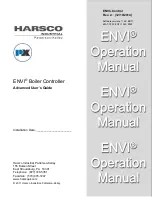
26
80-1403-01, Rev. 3
SETTING DEMAND SIGNAL
CHARACTERIZATION
The DCM‑3 incorporates a configurable
Demand signal characterization feature. In
addition to the standard linear response, there are
three characterization curves available: a square
function, a square root function, and a 20 segment
custom characterizer. These options allow the
user to set a non-linear response characteristic to
compensate for non‑linear final control elements.
Linear Function
0
10
20
30
40
50
60
70
80
90
100
0
10
20
30
40
50
60
70
80
90
100
Applied Demand (% Span)
Actual Position (% Span)
Square Function
0
10
20
30
40
50
60
70
80
90
100
0
10
20
30
40
50
60
70
80
90
100
Applied Demand (% Span)
Actual
Position
(%
Span)
Square Root Function
0
10
20
30
40
50
60
70
80
90
100
0
10
20
30
40
50
60
70
80
90
100
Applied Demand (% Span)
Actual Position (% Span)
NOTE: Implementing a square root characterization
creates extremely high gain when the Demand
signal is below 10%. This causes instability and is
unsuitable for control in this region. Do not apply
this curve if the conrol loop may need to modulate
at the lower range of valve/damper travel.
SPECIAL CURVE
The 20-segment characterizer allows the user
to emulate any curve profile by using a series
of straight lines. The straight lines are called
segments.
Special curves do not have to use all 20
segments, but the used segments must be grouped
together. Segments cannot be skipped.
Each segment is defined by a starting point
and an ending point. The starting and ending
points are called nodes. A node is an X,Y point
such as can be plotted on rectangular grid graph
paper.
Segment 1 starts at node 1 and ends at
node 2. Segment 2 starts at node 2 and ends at
node 3. Segment 20 starts at node 20 and ends at
node 21.
Unless otherwise specified, the Special curve
ships from the factory defined as a linear function.
This definition is accomplished by defining only
1 of the possible 20 segments. By defining the
first segment start point (node 1) as (X = 0%,
Y = 0%) and the first segment end point (node 2)
as (X = 100%, Y = 100%), all points between are
calculated to be on a straight line. To implement a
curve, more than one segment can be defined.
X-values are chosen to give a reasonable
spacing in Y-values. Y-values are calculated from
X-values using the desired formula, or are chosen
from X-values picked from a table of data.
When defining nodes, X‑values and Y‑values
must increase as the node number increases. For
example, the X-value and Y-value of node 2 must
be higher than the X-value and Y-value of node
1. Nodes cannot be skipped. Always start at
node 1.
The following example implements a special
curve that approximates a square function.
Mathematically, a square function multiplies the
Demand signal by itself, and uses the result as
the desired output. In this situation, Y-values are
calculated from X-values.
This example uses 5 segments to approximate
the square curve. Segments 1 through 5 are
needed, so nodes 1 through 6 are used.
Table 2 (left side) on page 27 describes the
Y-value calculation to determine the proper Y-value
after X-values were chosen. The right side of
Table 2 is the condensed result. The result values
are entered into the DCM-3.
DCM-3
Configuration
Содержание 14-100
Страница 85: ...85 80 1403 01 Rev 3 17 18 2 1 6 5 8 6 3 4 9 14 15 25 7 16 CONTROL ASSEMBLY AND DRIVE TRAIN...
Страница 87: ...87 80 1403 01 Rev 3 14 15 17 18 2 1 6 5 8 6 3 4 9 14 15 25 7 16 CONTROL ASSEMBLY AND DRIVE TRAIN...
Страница 90: ...90 80 1403 01 Rev 3 NOTES...
Страница 91: ...91 80 1403 01 Rev 3...
















































